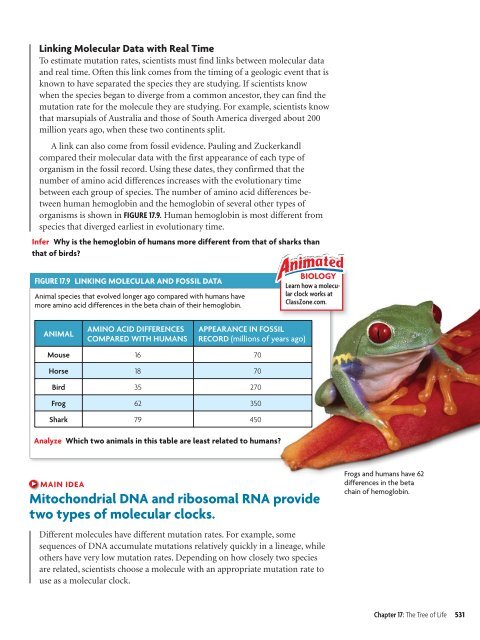Classification and Diversity
Classification and Diversity
Classification and Diversity
Create successful ePaper yourself
Turn your PDF publications into a flip-book with our unique Google optimized e-Paper software.
Linking Molecular Data with Real Time<br />
To estimate mutation rates, scientists must find links between molecular data<br />
<strong>and</strong> real time. Often this link comes from the timing of a geologic event that is<br />
known to have separated the species they are studying. If scientists know<br />
when the species began to diverge from a common ancestor, they can find the<br />
mutation rate for the molecule they are studying. For example, scientists know<br />
that marsupials of Australia <strong>and</strong> those of South America diverged about 200<br />
million years ago, when these two continents split.<br />
A link can also come from fossil evidence. Pauling <strong>and</strong> Zuckerk<strong>and</strong>l<br />
compared their molecular data with the first appearance of each type of<br />
organism in the fossil record. Using these dates, they confirmed that the<br />
number of amino acid differences increases with the evolutionary time<br />
between each group of species. The number of amino acid differences between<br />
human hemoglobin <strong>and</strong> the hemoglobin of several other types of<br />
organisms is shown in FIGURE 17.9. Human hemoglobin is most different from<br />
species that diverged earliest in evolutionary time.<br />
Infer Why is the hemoglobin of humans more different from that of sharks than<br />
that of birds?<br />
FIGURE 17.9 LINKING MOLECULAR AND FOSSIL DATA<br />
Animal species that evolved longer ago compared with humans have<br />
more amino acid differences in the beta chain of their hemoglobin.<br />
BIOLOGY<br />
Learn how a molecular<br />
clock works at<br />
ClassZone.com.<br />
ANIMAL<br />
AMINO ACID DIFFERENCES<br />
COMPARED WITH HUMANS<br />
APPEARANCE IN FOSSIL<br />
RECORD (millions of years ago)<br />
Mouse 16 70<br />
Horse 18 70<br />
Bird 35 270<br />
Frog 62 350<br />
Shark 79 450<br />
Analyze Which two animals in this table are least related to humans?<br />
MAIN IDEA<br />
Mitochondrial DNA <strong>and</strong> ribosomal RNA provide<br />
two types of molecular clocks.<br />
Different molecules have different mutation rates. For example, some<br />
sequences of DNA accumulate mutations relatively quickly in a lineage, while<br />
others have very low mutation rates. Depending on how closely two species<br />
are related, scientists choose a molecule with an appropriate mutation rate to<br />
use as a molecular clock.<br />
Frogs <strong>and</strong> humans have 62<br />
differences in the beta<br />
chain of hemoglobin.<br />
Chapter 17: The Tree of Life 531

















